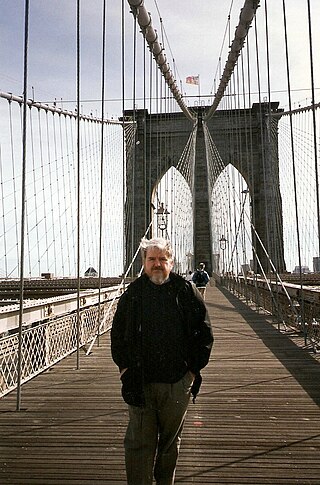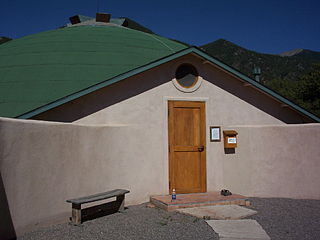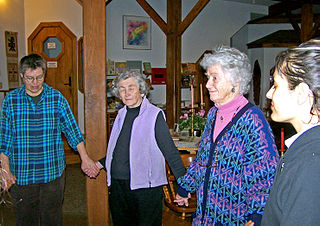
New Age is a range of spiritual or religious practices and beliefs which rapidly grew in Western society during the early 1970s. Its highly eclectic and unsystematic structure makes a precise definition difficult. Although many scholars consider it a religious movement, its adherents typically see it as spiritual or as unifying Mind-Body-Spirit, and rarely use the term New Age themselves. Scholars often call it the New Age movement, although others contest this term and suggest it is better seen as a milieu or zeitgeist.
The meaning of spirituality has developed and expanded over time, and various meanings can be found alongside each other. Traditionally, spirituality referred to a religious process of re-formation which "aims to recover the original shape of man", oriented at "the image of God" as exemplified by the founders and sacred texts of the religions of the world. The term was used within early Christianity to refer to a life oriented toward the Holy Spirit and broadened during the Late Middle Ages to include mental aspects of life.

The Findhorn Foundation is a Scottish charitable trust registered in 1972, formed by the spiritual community at the Findhorn Ecovillage, one of the largest intentional communities in Britain. It has been home to thousands of residents from more than 40 countries. The Foundation closed all its educational programmes in September 2023 whereas the Findhorn community eco village at Findhorn houses about 40 community businesses such as the Findhorn Press and an alternative medicine centre.
Peter Caddy was a British caterer, hotelier, and with his wife Eileen Caddy and their friend Dorothy Maclean, co-founder of the Findhorn Foundation community.
Caroline Myss is an American author of 10 books and many audio recordings about mysticism and wellness. She is most well known for publishing Anatomy of the Spirit (1996). She also co-published The Creation of Health with Dr C Norman Shealy MD - ex Harvard professor of neurology. Her most recent book, Archetypes: Who Are You? was published in 2013. Myss describes herself as a medical intuitive and a mystic.
A vision quest is a rite of passage in some Native American cultures. It is usually only undertaken by young males entering adulthood. Individual Indigenous cultures have their own names for their rites of passage. "Vision quest" is an English-language umbrella term, and may not always be accurate or used by the cultures in question.
Spiritual ecology is an emerging field in religion, conservation, and academia that proposes that there is a spiritual facet to all issues related to conservation, environmentalism, and earth stewardship. Proponents of spiritual ecology assert a need for contemporary nature conservation work to include spiritual elements and for contemporary religion and spirituality to include awareness of and engagement in ecological issues.

William Irwin Thompson was an American social philosopher, cultural critic, and poet. He received the Oslo International Poetry Festival Award in 1986. He described his writing and speaking style as "mind-jazz on ancient texts". He was the founder of the Lindisfarne Association, which proposed the study and realization of a new planetary culture.

Sacred dance is the use of dance in religious ceremonies and rituals, present in most religions throughout history and prehistory. Its connection with the human body and fertility has caused it to be forbidden by some religions; for example, some branches of Christianity and Islam have prohibited dancing. Dance has formed a major element of worship in Hindu temples, with strictly formalized styles such as Bharatanatyam, which require skilled dancers and temple musicians. In the 20th century, sacred dance has been revived by choreographers such as Bernhard Wosien as a means of developing community spirit.
Sheena Govan (1912–1967) was an informal spiritual teacher, and the daughter of evangelist John George Govan. Later in life she became an early influence on what would become the Findhorn Foundation. Her career demonstrated some of the links between Evangelicalism and early New Age thought.
The phrase "Earth Changes" was coined by the American psychic Edgar Cayce (1877–1945) to refer to the belief that the world would soon enter on a series of cataclysmic events causing major alterations in human life on the planet.
Eileen Caddy MBE was a British spiritual teacher and New Age writer, best known as one of the founders of the Findhorn Foundation community at the Findhorn Ecovillage, near the village of Findhorn, Moray Firth, in northeast Scotland. The commune she started in 1962 with husband Peter Caddy and friend Dorothy Maclean was an early New Age intentional community where thousands of people from dozens of countries have resided in years since. One of the UK's largest alternative spiritual communities, The Sunday Times referred to it, on Caddy's death, as "the Vatican of the New Age".

The Lindisfarne Association (1972–2012) was a nonprofit foundation and diverse group of intellectuals organized by cultural historian William Irwin Thompson for the "study and realization of a new planetary culture".
Secular spirituality is the adherence to a spiritual philosophy without adherence to a religion. Secular spirituality emphasizes the inner peace of the individual, rather than a relationship with the divine. Secular spirituality is made up of the search for meaning outside of a religious institution; it considers one's relationship with the self, others, nature, and whatever else one considers to be the ultimate. Often, the goal of secular spirituality is living happily and/or helping others.

Dorothy Maclean was a Canadian writer and educator on spiritual subjects who was one of the original three adults at what is now the Findhorn Foundation in northeast Scotland.
Robert Lawlor was an American mythographer, symbologist and New Age author of several books.
Robert Ogilvie Crombie, also known as "ROC", was a Scottish supernatural enthusiast and writer born in Edinburgh, Scotland in 1899 and lived there for most of his life.

David Steindl-Rast OSB is an Austrian-American Catholic Benedictine monk, author, and lecturer. He is committed to interfaith dialogue and has dealt with the interaction between spirituality and science.
Ted Andrews was an American writer, teacher of esoteric practices, and a clairvoyant. His book on animals as spirit guides and symbols, Animal Speak, sold almost 500,000 copies from 1993 to 2009; the influential Llewellyn-published book is widely cited by others.






